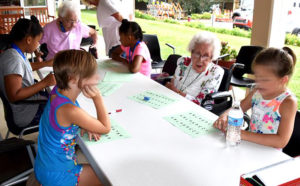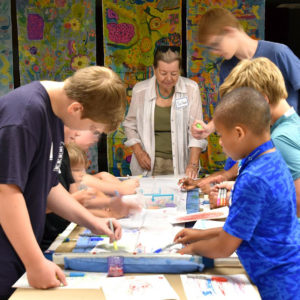Young and Old Alike Find Joy in Intergenerational Art Program with UCC-related Brewster Place

The idea for the intergenerational arts program came from last summer’s week-long STEAM camp at Brewster place.
A one-week summer school camp has blossomed into a new intergenerational program for residents of UCC-related Brewster Place — an older adult community in Topeka, Kan. — and nearby Quincy Elementary School.
Last summer, students in the summer program at Quincy came to Brewster Place for STEAM-themed (Science, Technology, Engineering, Arts and Math) activities. They also worked on a collaborative art project that was so successful that Katy Wright, Brewster’s intergenerational activities coordinator, and Susan Liotta, Quincy’s principal, talked about repeating the program this year. But neither wanted to wait till summer.
“We didn’t want to wait that long to have another activity,” says Wright, “so we came up with the idea for an after-school art program.”
From February through April, Brewster participants are heading over to Quincy one afternoon a month to meet with the students in small groups and assist them in creating an art project. Each month’s project has a different theme.
The art program dovetails with Quincy’s designation as a Signature Visual Arts School. In a signature school, students have art class and art integration once a week. The many guest artists that have come to Quincy include Native American traditional dancers, performers from the Alvin Ailey American Dance Theater, puppet theaters, a stone mason, published authors, and illustrators, among others.

The program features students and residents working together on art projects.
The benefits of the Brewster-Quincy program can be felt by all participants.
“Intergenerational programs allow both older adults and children the opportunity to create and share a special bond with someone they wouldn’t normally interact with,” Wright says. “It gives all parties involved a sense of meaning and purpose as they organically create these relationships.”
Some 92 percent of students at Quincy are from low-income families, so arts programming provides them with experiences they might not have otherwise. “Quincy Elementary is located in a high-risk area,” says Wright. “We want these students to be allowed opportunities that may not typically be accessible to them.”
The three-month program will culminate in an art showcase at the NOTO Arts Center (North Topeka Arts District),which is home to art shows, classes and other cultural events. On May 3, the school’s student art — from books to a film to acrylic art — will be displayed at the center. Among the works will be art from the students and their “Brewster Buddies.” During the show, “students have the choice to sell or keep their works — like professional artists,” Wright says. “All of the money from the art sales goes directly to the students.”
Studies have shown that intergenerational programming benefits all participants. For adults, such programming enhances socialization, stimulates learning, provides emotional support and improves health and well-being. For children, intergenerational programs can improve academic performance, provide a sense of stability, decrease negatives behaviors, improve social skills, and encourage cultural learning.
Wright says the impact on the Brewster residents is immeasurable. “In today’s society,” she adds, “families are living further apart, so there are fewer opportunities for interaction between generations. Many of our residents say they feel so much joy after leaving an activity with the students.”
Join Our Mailing LIst
Follow on Facebook
Iredell Adult Day Services Hosts Ribbon-Cutting to Celebrate Adult Day Health Certification - CHHSM
www.chhsm.org
Iredell Adult Day Services (IADS) in Newton, N.C. — a nonprofit organization dedicated to caring for older adults, vulnerable groups, and their families, and part of EveryAge — hosted a ribbon cut...